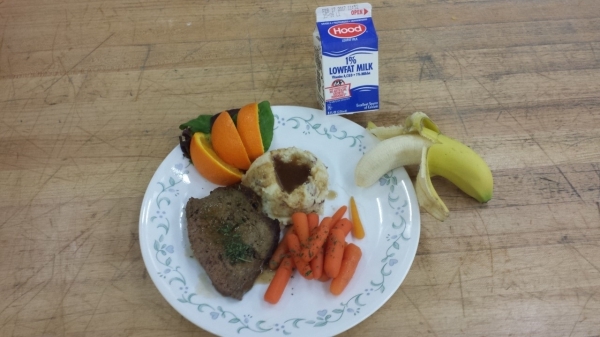BRATTLEBORO — School lunch is not what you remember.
Sure, there are chicken nuggets and pizza on some school menus. But there's just as likely to be a beef meatloaf with flax seeds served with mashed local red potatoes, gravy, and baby carrots glazed with local maple syrup - a meal recently served by Donovan Hunt of Café Services, food service director for the Brattleboro elementary schools.
School food has definitely changed in the last few years, with more fruits and vegetables, more local foods, and more nutrition on the tray.
Part of the change is driven by standards handed down by the U.S. Department of Agriculture, which reimburses schools for meals. These nutrition standards require schools to offer a fruit and vegetable at every meal as well as milk.
Standards for nutritional markers, including trans fats and sodium, are also laid out. The Brattleboro town elementary schools have gone even further in a new commitment to eliminating high-fructose corn syrup, hydrogenated oils, and trans fats; lowering sugar content; increasing student intake of omega-3 fatty acids (remember the flax seeds in the meatloaf?); purchasing local and regional foods; and using only whole-grain products.
* * *
The real change in our region, however, has come from an increased focus on local ingredients and food quality.
Local nonprofit Food Connects has worked closely with school boards, administrators, school chefs, and food service providers to incorporate local ingredients into the menus and deliver local food right to their respective school doors.
To do so, Food Connects has used grant funding and donations to purchase dozens of kitchen tools and pieces of equipment to allow chefs to more efficiently process raw ingredients: potato wedgers, immersion blenders, salad spinners, and food processors.
A steady stream of local potatoes, apples, salad greens, broccoli, kale, root vegetables, and maple syrup now makes its way into school kitchens around Windham and Cheshire counties through Food Connects' two food hubs: Windham Farm & Food and Monadnock Menus.
The fresh potatoes, for example, are used to make baked potato wedges instead of frozen french fries or tater tots. Apples are served as whole fruit or made into sauce. (New storage techniques make it possible to keep local apples throughout the year.)
The other vegetables are used in a variety of ways - steamed, roasted, mashed, pureed - but never fried.
Many of the crops that come through the kitchen are also featured throughout schools through a robust taste-testing program based around the Harvest of the Month. Students sample recipes made with the Harvest of the Month - a local, seasonal product such as cabbage, radishes, or apples - and offer feedback, with some successful recipes finding their way onto the regular menu in the cafeteria.
Additionally, teachers, chefs and volunteers deliver lessons related to the current Harvest of the Month to the students as a way of reinforcing the learning from the taste test. Students often record their reactions to the food in some way, incorporating the lesson into their math, science, or language curriculum.
Usually, the Harvest of the Month is featured in the cafeteria throughout the month, so students have multiple opportunities to try it. It can take many exposures to a new recipe before a child begins to eat it or like it, and seeing other children eat it with gusto often helps.
So, the food service staff incorporate the Harvest of the Month into the menu in a variety of ways, and may have a special taste test in the cafeteria as well. Café Services now highlights the Harvest of the Month in its Try a Bite Program, which is featured monthly in all of its school accounts across Vermont and New Hampshire.
* * *
Any teacher will tell you that hungry kids can't learn, and school meals have become a very important tool in the fight against childhood hunger in this country.
In Windham County, about 1 in 4 children experience food insecurity at home, meaning they aren't always sure where their next meal is coming from. Luckily, those students and many more (somewhere around 50 percent, depending on the school) qualify for free breakfast and lunch. In some schools, after-school snacks or meals are also available.
This program gives hungry students two or three nutritious meals each school day, allowing parents to focus their limited food dollars on supper and weekend meals.
In Windham and Cheshire counties, school meals are prepared with an increasing proportion of fresh, local food. With your help, they can have even more. When more kids participate in the school lunch program, either by purchasing school lunch or applying for free meals, the finances of the program improve. By law, any money earned must be reinvested into the program.
Because we have a robust Farm to School program in place in this region, that means more local products and better school food - not to mention more investment in our local food system!
Many parents are surprised to learn that their children will qualify for free school breakfast and lunch, so it's worth checking. Increasing the number of families applying for free school meals may help your school qualify for universal (free) meals and other federally funded programs, so talk to your school administrator or guidance counselor about how to apply and see if you qualify.
And, give school lunch a try - it's come a long way from the “mystery meat” patty of the past.
